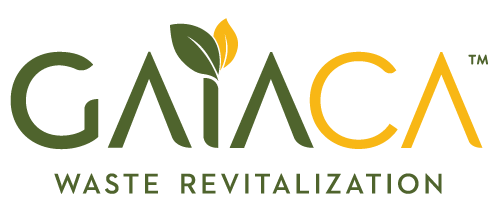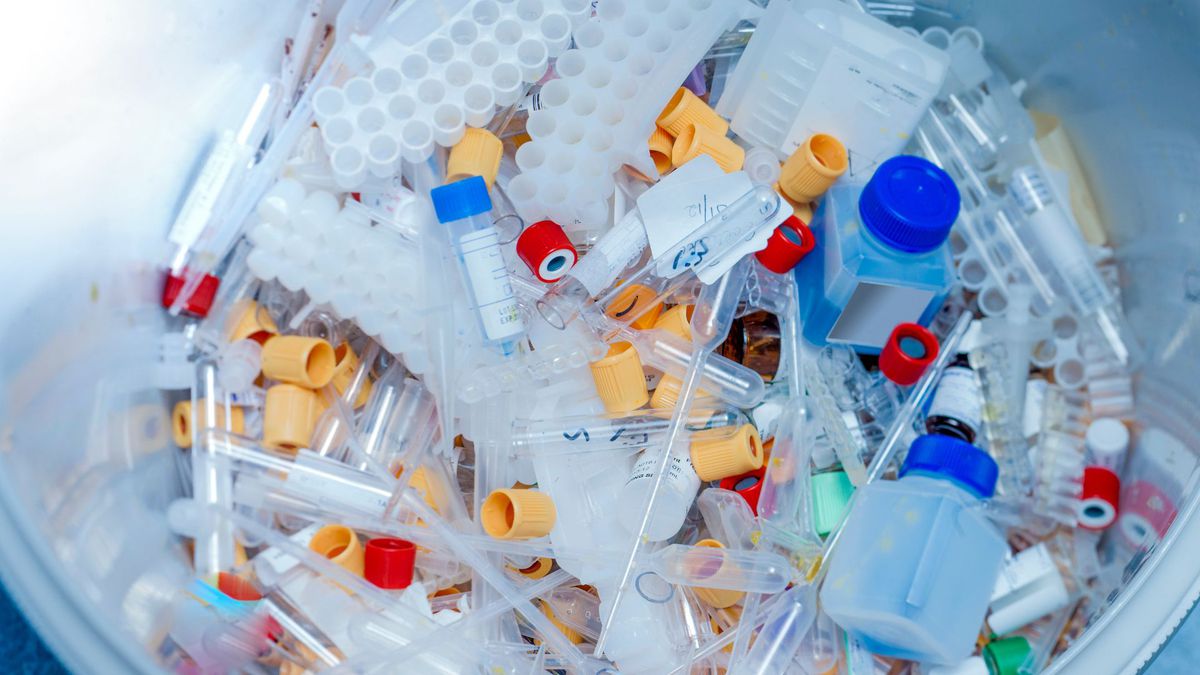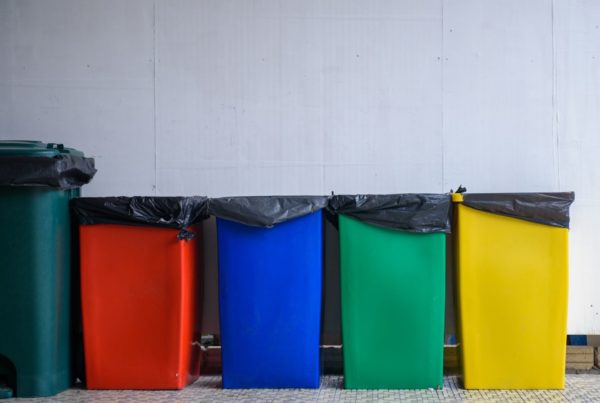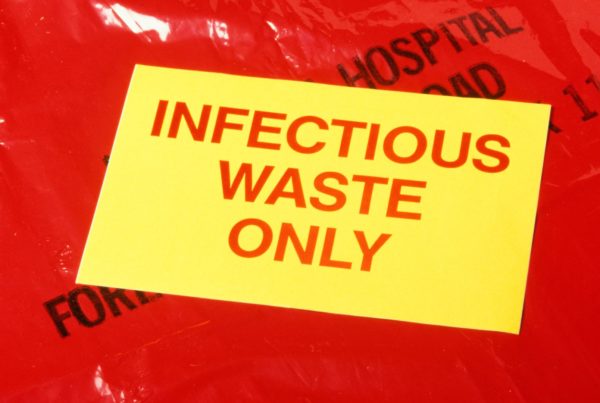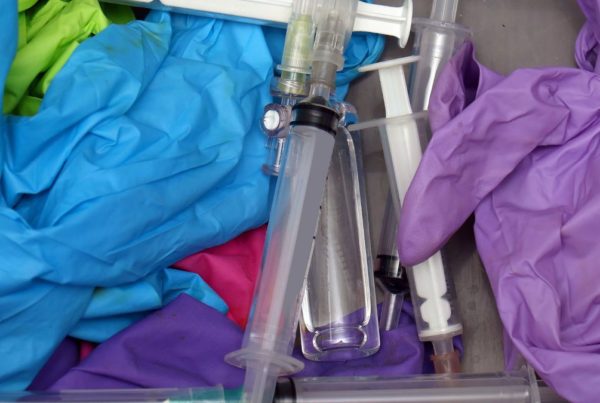There are several types of medical waste and several ways in which medical waste can be classified, which means there won’t be a one-size-fits-all answer when it comes to separating and disposing of waste generated in healthcare facilities. Initially, the Environmental Protection Agency was in charge of defining and tracking medical waste in the United States. However, today, the responsibility for defining and regulating medical waste is largely in the hands of each state.
Types of Medical Waste: Federal Classifications
Environmental Protection Agency
At the federal level, medical waste was initially defined and tracked by the Environmental Protection Agency (EPA) as part of the three-year Medical Waste Tracking Act of 1988. The EPA website defines medical waste as “healthcare waste that may be contaminated by blood, body fluids or other potentially infectious materials and is often referred to as regulated medical waste.”
More details are given in the EPA’s Manual for Infectious Waste Management which serves as a guide for other regulatory bodies. The types of medical waste listed in the guide are:
- Isolation wastes
- Cultures and stocks of infectious agents and associated biologicals
- Human blood and blood products
- Pathological waste
- Contaminated sharps
- Contaminated animal carcasses, body parts, and bedding
In addition, medical and healthcare facilities often produce other kinds of regulated waste, including:
- Hazardous waste
- Radioactive waste
Hazardous waste includes non-infectious waste types that pose a threat to human or environmental health, such as chemicals and explosives. These are defined and regulated under the Resource Conservation and Recovery Act, which is overseen by the EPA. There are also non-RCRA-regulated hazardous wastes that are often regulated at the state level. Radioactive waste, including nuclear waste, is regulated by the Nuclear Regulatory Commission.
If any hazardous waste products, including chemicals, make their way into the drain, this comes under the jurisdiction of the Clean Water Act and state water administrations. Your healthcare facility may need a wastewater assessment or environmental consulting to determine your current environmental impact before creating an appropriate medical waste disposal plan.
Center for Disease Control and Prevention (CDC)
In contrast to the EPA, which focuses on the environmental impact of waste, the Center for Disease Control and Prevention focuses on the potential for a waste product to transmit disease.
The CDC categories for medical waste include:
- Microbiological waste
- Pathology and anatomical waste
- Blood specimens from clinics and laboratories
- Blood products
- Other bodily fluid specimens
- Contaminated needles and sharps
Compared to many state administrations, the CDC is less stringent as far as separating contaminated items from general waste.
Department of Transportation
The Department of Transportation has nine classes of hazardous materials that include several that are relevant to medical facilities:
- Poisonous substances (Class 6)
- Infectious substances or etiological agents (Class 6.2)
- Radioactive material (Class 7)
- Corrosive material (Class 8)
- Miscellaneous hazardous material (Class 9)
These classes are listed and defined in CFR Title 49, Subtitle B, Chapter I, Part 173 and are relevant for medical facilities, clinics, research facilities, and laboratories in terms of correct lab packing and hazardous waste management when waste products will be transported on public roads and highways.
General Waste
Finally, all healthcare facilities produce general waste, which is not regulated and can either be recycled or disposed of in landfills. In fact, around 85% of the waste generated in medical and healthcare facilities around the world is unregulated, general waste.
Types of Medical Waste: State Classifications
Thoroughly confused? This is where it gets really fun. Each state has its own classifications for types of medical waste and rules for medical waste disposal. Let’s take a look at a few states…
California
In California, medical waste streams are defined by California’s Medical Waste Management Act of 2017 and regulated by the California Department of Public Health.
According to the MWMA (pp. 11-13), medical waste can be separated into:
- Biohazardous waste
- Pharmaceutical waste
- Pathology waste
- Trace chemotherapy waste
- Trauma scene waste
Florida
The Florida Department of Health and Florida Department of Environmental Protection are jointly responsible for the Sunshine State’s Biomedical Waste Program, outlined in Section 381.0098, Florida Statutes, and Chapter 64E-16 of the Florida Administrative Code (FAC).
According to these state regulations, medical waste includes:
- Biomedical waste – defined as:
- “Any solid or liquid waste which may present a threat of infection to humans, including non-liquid tissue, body parts, blood, blood products, and body fluids from humans and other primates”
- “Laboratory and veterinary wastes which contain human disease-causing agents”
- “Discarded sharps”
- Absorbent materials that are contaminated with blood or bodily fluids
- Non-absorbent devices that are contaminated with blood or bodily fluids and haven’t been treated by an approved method
Michigan
In Michigan, medical waste is regulated under three specific laws:
- Medical Waste Regulatory Act (MWRA)
- Michigan Compiled Laws (MCL) 333.13801 to 333.13831
- Michigan Administrative Code (MAC) r. 325.1541 to 325.1549
The types of medical waste as defined in Michigan include:
- Cultures and stocks
- Pathological waste
- Liquid human and animal waste
- Sharps
- Contaminated animal waste
How Do Generators and Waste Management Providers Deal with the Different Types of Medical Waste?
What is ultimately of interest to any person or facility that generates any of these types of medical waste (officially referred to as a “medical waste generator”) is how they need to store and dispose of this waste to avoid causing an injury or getting into trouble with the law.
Because medical waste streams are defined so differently from state to state, healthcare facilities usually partner with a healthcare waste management company that understands the local regulations and can take care of storage and compliance. However, having some initial information will help you make a good start.
Infectious Medical Waste
Infectious waste or pathological waste—depending on definitions—includes potentially infectious material, such as:
- Anything that has been contaminated with blood or body fluids, including surgical waste
- Human tissues
- Human body parts
- Contaminated animal carcasses
Infectious or pathological waste products should be placed in a closed, appropriately labeled, and correctly colored bin. Then, medical waste disposal services will take the waste for incineration or sterilization to render them non-infectious, after which it can be transferred to a landfill.
Hazardous Medical Waste
Hazardous medical waste covers a wide range of materials, including:
- RCRA-regulated hazardous waste (such as toxic and corrosive chemicals and heavy metals like mercury)
- Non-RCRA-regulated hazardous waste (such as antifreeze)
- Cytotoxic drugs, including chemotherapy agents
- Pharmaceutical waste, such as expired pills
- Aerosols, such as asthma inhalers
- Sharps, including needles, syringes, scalpels, and broken glass
Hazardous waste: Chemicals, heavy metals, aerosols, and cytotoxic drugs should be stored in secure, substance-compatible, leakproof containers with correct hazardous waste labeling.
Pharmaceutical waste: Expired pharmaceuticals can usually be returned to the manufacturer for appropriate disposal.
Sharps should be stored in a sharps container that’s compliant with FDA requirements for sharps disposal and the OSHA bloodborne pathogens standard to protect employees.
Radioactive Medical Waste
Radioactive waste includes radioactive materials and medical equipment used in the course of X-ray diagnostics, cancer therapies, and nuclear medicine treatments. This kind of medical waste needs to be stored in sealed, clearly-labeled containers for treatment or burial deep in the earth.
General Medical Waste
General medical waste and medical office waste can simply be recycled or disposed of in a trash can the way you would in any other business. Things like paper, plastic, and cardboard can be recycled, and dust swept off the floor can be sent to a landfill.
Keep in mind that under the Health Insurance Portability and Accountability Act (HIPAA), patient information and medical records that have expired will need to be stored securely and shredded properly prior to recycling. In addition, universal waste items like batteries, light bulbs, and electronic waste will need to be taken to the appropriate recycling facility or municipal drop-off point and not placed in the general trash.
Understand Your State Regulations for the Correct Disposal of Medical Waste
Determining the types of medical waste isn’t a simple task, thanks to differences between the various federal agencies as well as differences between the states. One thing to keep in mind is that medical-type waste isn’t limited to medical facilities. It can show up in even the most unlikely of industries, such as the nascent cannabis industry (which produces a lot of RCRA-regulated hazardous waste). That’s why most cannabis companies rely on specialty cannabis waste disposal providers.
To ensure that you’re disposing of things like infectious waste and sharps waste correctly, take the time to find out your state’s regulations and partner with a hazardous waste disposal company that can make sure your facility complies.
